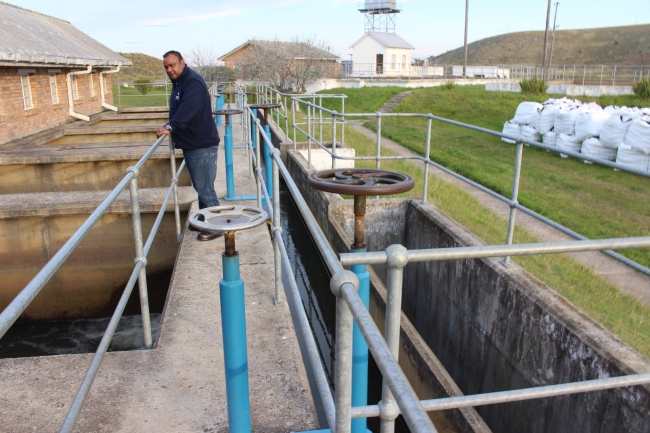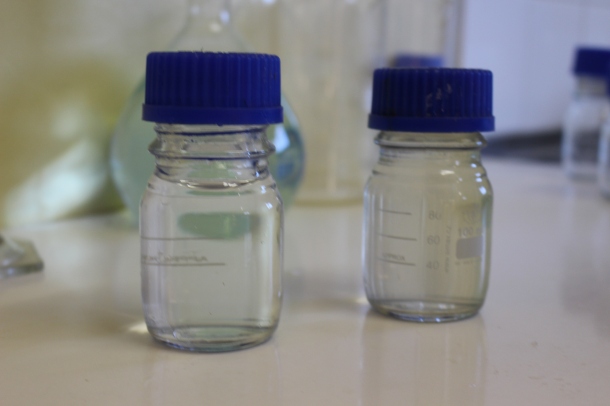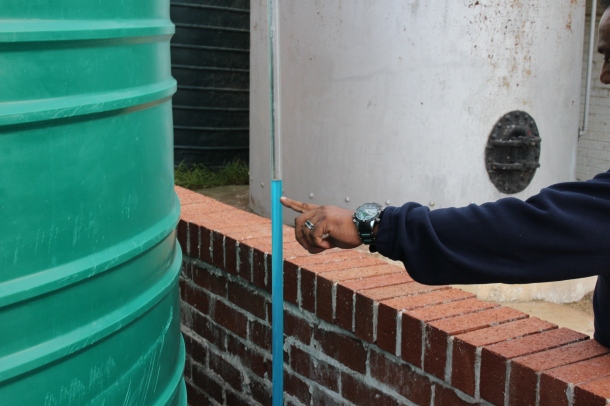The quality and supply of Grahamstown’s water has improved dramatically over the past six months under the stewardship of Amatola Water and the gradual implementation of the R54 million Water Crisis Intervention Project. But, Makana’s water systems are still on the mend – and are often turbulent and leaky. Embizweni reporter Emily Corke fills us in.

Amatola Water’s Chris Nair looks over the final stages of the water treatment at the Waainek plant at the end of Mountain Drive. Pic: Emily Corke.
Earlier this year new water monitoring systems and technologies were introduced at all the water treatment works in the district and water was being sampled and tested every hour. Amatola’s Chris Nair hailed these new technologies and tighter scheduling of water sampling as “the Rolls-Royce of water testing.”
Sadly, some of this new equipment was vandalised at the end of June. The culprits were never found and Nair said that Amatola still feared for the safety of the new equipment.
“These stations are in remote areas and the current security is not working,” said Nair, “They have managed to breach both electric fences.”
Until the security has been strengthened there has been a hold on the replacement of the vandalised technology.
This is typical of Makana’s epic water saga – two steps forward, one step back.
Following the extended collapse of large amounts of Makana’s water supply last year, Amatola Water was contracted to manage water allocation, water treatment, water management and to facilitate the training of the municipal staff operating our water systems.
Amatola Water was supposed to be paid using funds allocated to the Department of Water Affairs and various other parties, including a R50 million rescue package administered by the Eastern Cape Development Corporation (ECDC).
However, the intervention project hit another snag in July when Amatola Water workers were asked to withdraw from Makana after they had received no payment for their services.
After an emergency Makana council meeting, ECDC money was redirected to Amatola for the next financial year.
Further problems arose when the South African Municipal Workers Union (Samwu) embarked on a nine-day-long wildcat strike. The strike affected Amatola with localised interruptions at the water reservoirs.
The relationship between municipal workers and Amatola has been fraught with tension. Municipal workers were initially unhappy with Amatola’s arrival. SAMWU confirmed high levels of tension between municipality staff and Amatola.
Nair said, “The Makana staff did not want to take orders, especially in October last year when we first came in and it was all about rapid response.”
He went on to say that the problem was from the supervisor level down to the worker level. In March, striking intensified and there were reports of intimidation against non-striking Amatola workers.
Nair has confirmed that while their relationship has improved, it will never be perfect.
Despite this, the water supply was consistent throughout the National Arts Festival.
Since the end of the festival there have been a number of major pipeline leaks. Nair said this was causing a higher demand on water traveling to Grahamstown East. “But, we are managing that and all plans are working at an accelerated pace,” he said.
He added that the updating of standby equipment was well underway and should be completed by the end of the year.
Meanwhile, there is plenty of evidence to suggest that Grahamstown’s water quality is on the mend. The Waainek Treatment Plant rose to 99.4% compliance with the national standards in April this year compared with a 54% rating for the same plant in October 2013.
This equipment at the Waainek water treatment works is decribed by Amatola Water’s Chris Nair as the Rolls-Royce of water testing technnology. Each of Makana’s four water treatment plants – at James Kleynhans, Waainek, Riebeeck East and Alicedale – is equipped with these units. Picture: Emily Corke.

Samples of water at the Waainek water treatment works before treatment (right) and after treatment (left). Pic: Emily Corke.

Amatola Water’s Chris Nair points to a jar test system which controls the dosing of water with a polyelectrolyte blend. This polyelectrolyte blend replaced the aluminium sulphate flocculation chemical wihch was previously used at the Waainek water treatment works. Pic: Emily Corke. High traces of aluminium were previously found in the final water due to the over-enthusiastic use of aluminium sulphate in the old chemical dosing system. Pic: Emily Corke.

This is a great story and the accompanying pictures really help in explaining the story further.
LikeLike
I had no idea the water quality had improved this year. I imagine it is less than great now, because it is bizarrely milky, but hopefully things will return to normal soon.
LikeLike
I wonder the long-term effects of drinking Makana water are? It tastes worse every time I drink it.
LikeLike
I wonder how the issues around water will progress with the current upheaval in Grahamstown’s local government. It all seems like short term solutions for a long term issue.
LikeLike
Informative article and yes, somewhat uplifting to feel that the Grahamstown water crisis is not totally dire. However as a 16-year-long local and after spending the past 8 days without water, “short term solutions for a long term issue” is exactly how the water crisis continues to appear to me.
LikeLike
This is really informative. I did not know that there was so much behind the water crisis in Grahamstown. The pictures also add to the story and paint a more vivid picture. More people should know about what is happening in their community.
LikeLike
In light of the recent water outage, it’s great to see that everything isn’t as dismal as it seems to be. A really well-written piece that informed me about a few things I didn’t know. I’m especially interested in the last bit of information about the rising compliance with national standards. Hopefully there will be more information about this: I’m interested to see what is going better with our water, and what’s still not so great about it. Better to be informed than brush my teeth in ignorance.
LikeLike
Very informative piece with descriptive, accompanying photos.
LikeLike
I think Embizweni needs to do a follow up on water quality now – in the wake of the latest chaos. Is it still milky everywhere and what does this mean?
LikeLike
Now know a number of things about what Makana is doing to fix the problem. Thanks for the info.
LikeLike
I heard that a woman Janice Limson did a study in which she concluded that in 5 years everyone in Grahamstown would be dead due to the water. Yet your story seems really enthusiastic. Should we Grahamstonians be worried?
LikeLike
This was a very informative piece, and the photos made it pleasant to read. Like others have mentioned, I find it interesting that the quality of the water has improved this year. I disagree with that statement, which makes me question the municipality’s honesty.
LikeLike
I found this article easy to read and understand – which is always helpful for someone who knows almost nothing about the issues that were covered. It’s well written, clearly very well researched and bursting with useful information.
LikeLike